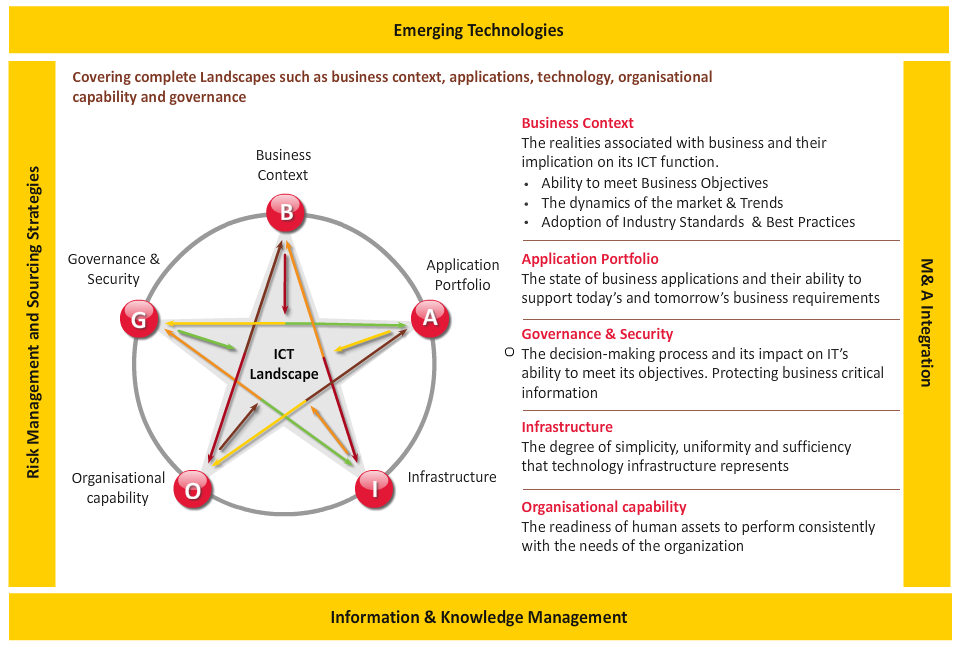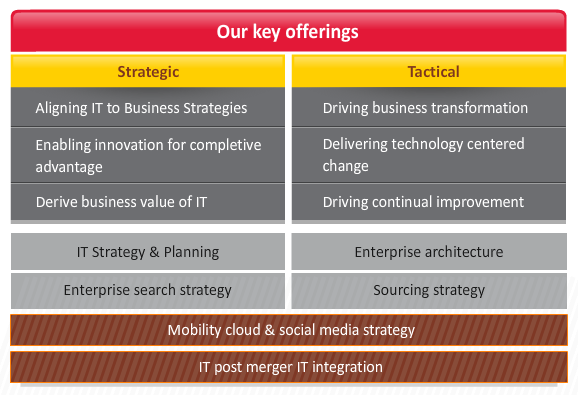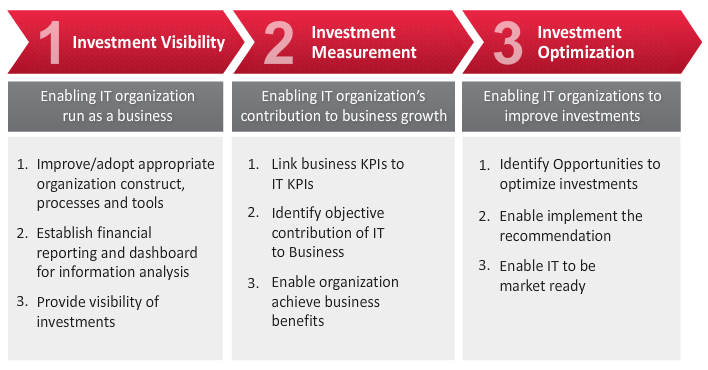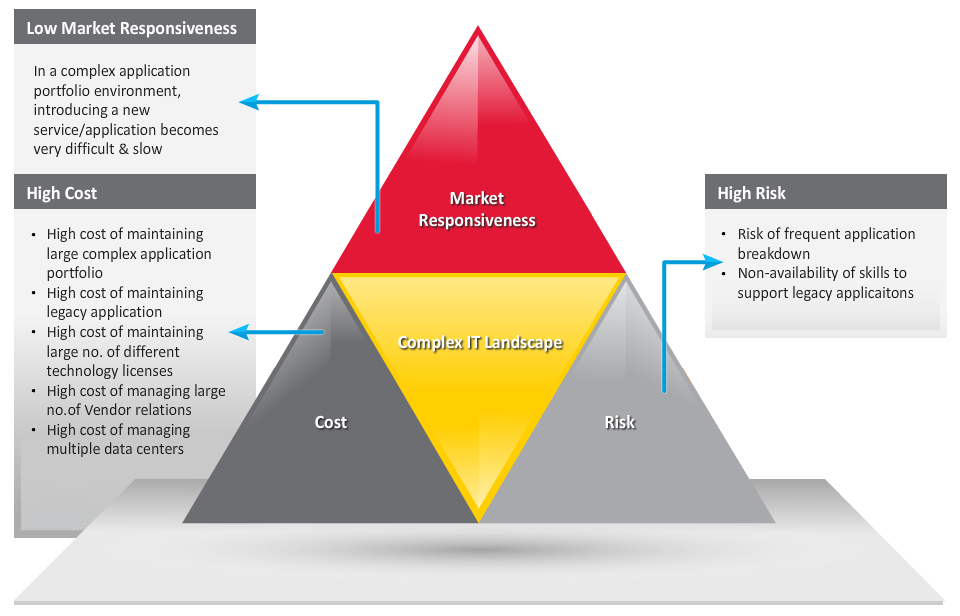
Technology Advisory
Customers use services from Business Value Enhancement’s Information and Communications Technology (ICT) Advisory and Transformation services to enhance the business value of ICT investments and to make smart investments in ICT.
Organizations worldwide realize and appreciate the difference Information Technology (IT) can make to an organization’s functioning. They are on the lookout for opportunities to deploy IT in a manner that provides differentiation and competitive advantage. Senior IT leadership struggle to balance the often conflicting need to deliver capabilities while controlling IT spend. Current technological innovations such as mobility, big data and innovative ”everything as a service” delivery models make up the other pieces of the puzzle IT needs to solve.
Our customers are typically the senior management of IT functions. They use our services to increase the value perception of IT, improve IT performance, increase agility and deliver competitive advantage to business. They realize that our services enable them to build a combination of right strategy, fit for purpose organization and internal processes and tools to achieve these objectives.
We group the various ways in which customers use our services under three broad themes.
Strategize ICT
Customers wanting to innovatively use IT to deliver business advantage, work with us to strategize their IT. Customers use our services to streamline existing IT assets and to apply evolving technological innovations such as social media, analytics, enterprise mobility and enterprise search to gain competitive advantage. Read more on how we can enable you to gain advantage from better use of IT.
Customers engage us and continue to stay engaged with us due to:
- Our ability to take responsibility and ownership for a desired outcome and work with our customers to deliver it
- Our collaborative way of delivering services
- Our proven knowledge assets that enable customers to take informed decisions and implement decisions quickly
Run IT as a Business
Customers focused on improving business delight and demonstrating improved stewardship of the ICT budget ask for our support to “Run IT as a business”. Our advisory services in this area enable our customers establish demand management functions within IT, set up appropriate mechanisms to improve visibility of IT performance through well-defined catalogs and measures, better budget stewardship through benefit realization models, service costing models and enhanced control functions. Read more on how our customers benefit by running IT as a business.
Simplify ICT
Customers use services from our Simplify ICT portfolio to improve agility and performance of the IT function. Customers saddled with sprawling IT estates, unwieldy IT organizations and complex processes use our services to systematically identify and rationalize IT assets (application and infrastructure), streamline the IT function and improve processes and tools used within IT. Read more on how our clients have dramatically improved performance through simplification of ICT.
1. Strategize Information and Communications Technology
Technology advancements and emergence of new models of engaging with technology and service providers have made yesterday’s ‘future proof’ business models obsolete. For example, cloud computing has obviated the need for large storage spaces, mobility has made customer experience seamless and agile, on demand services (‘as- a- service’ model) have made availability of applications and computing power no longer a necessity but a hygiene factor.
These, with little or no massive capital upfront investments, combined with the ‘Pay as you go’ model have truly leveled the playing field. Size no longer decides the winner, agility does. Investments do not guarantee success, innovation does.
Businesses that embraced these changes thrived. Take for example the Banking Industry – mobility provides access to new markets (for instance, banking the unbanked), new mobile payment methods (including micro and contactless payments) and better use of channels (such as independent financial advisors employed by banks) to prospect for new customers.
A Turkish bank with a $61 billion-asset offers mobile banking services. In the first two months, its mobile banking portal signed up an astonishing 50,000 customers who racked up more than 30,000 transactions and $24 million in transaction volume.
A Japanese bank with no branches or ATMs, almost three million customers and a meager 195 employees work force provides 24-hour real-time electronic services.
Businesses which strategize information and communications technology (ICT) elevate the experience of their stakeholders. However, strategizing ICT should also help protect existing investments in technology and ensure additional investments that are made, drive positive business outcomes.
We bring similar experiences and best practices of helping customers, globally, to help navigate through a maze of technology landscape to deliver business results in the shortest possible time. Components of Strategize ICT offerings include ICT Strategy and Planning, Enterprise Mobility Strategy, Social Media Strategy, Sourcing Strategy, Post Merger and Acquisition IT Integration Strategy.
The key benefits delivered through our work have been in the following areas:
- Enabling ICT organizations to be agile and responsive to changing business dynamics and needs.
- Optimizing ICT resources and capabilities to meet current and future business requirements.
- Overcoming prevailing paradigms and structural deficits in the existing ICT structure.
- Partnering with business to create synergies which are essential for success
We assist organizations in identifying and deploying technologies and related mechanisms that enable them to create value for their customers and investors. Through strategic Information and Communications Technology (ICT) thinking, we enable customers transform the existing ICT functions into new world enablers utilizing the new technological advancements. Our approach and thinking has helped organizations develop synergies, business IT alignment, improved agility and flexibility, achieve high performance, maximize value and drive competitive advantage.
Here is our point of view on some of major IT landscape changes and what it means for business:
- Read our point of view on Social Media adoption by government services, ‘Social Government’. With the change in citizenry behavior, it becomes imperative for Governments to get socially engaged leading to Social Government. Many local authorities are socially engaging themselves on an ‘opt-in’ basis, via tweets or text messages to mobile phones.
- To explore ‘E-Services in real estate’, refer to this paper – ‘Bringing customer service home’.
- Find out about BITIL – A process framework to make New IT work in the financial sector – ‘An integrated process framework and implementation methodology that would enable the IT function to address the challenges financial sector is currently facing’.
- Discover the Technology Trends in 2012: ‘The tech trends of 2012 are the ones that have crossed the chasm and forward thinking CIOs are rapidly adopting them to ready their organizations for the new order and growth’.
- Explore the changing business models and drivers in the financial sector and the key role of IT.
Organizations must follow a holistic approach to develop strategies for information and communications technology (ICT) taking inputs from business strategy, business objectives, business drives, market trends etc and leverage industry standards, available best practices, emerging technologies and platforms. Our “Strategize ICT for competitive advantage” approach has been developed based on our ICT Strategy Framework.
It has been utilized to deliver value to customers across the globe. This framework constitutes all vital components needed to develop a robust strategy planning and roadmap and ensure strong Business -IT interlock.
We have experience in delivering value through our strategize information and communications technology (ICT) initiatives across the globe. Here are a few customer scenarios where we have been able to create value:
- Read how we enabled an Information Infrastructure company chart their Enterprise Mobility Roadmap
- Read how we have enabled a Leisure, Food and Beverages organization enhance value delivered to stakeholders through an efficient IT Strategy
- Check out how our solution helped a digital entertainment firm improve and enable its service management process
- Find out how we enabled a Private Equity Firm keep pace with its growth plans
2. Run Information Technology as a Business
Customers use Business Value Enhancement’s “Run IT as a business” advisory services to improve business satisfaction and demonstrate stewardship of the IT budget.
- Do you regularly get blindsided by competitions that seem able to introduce improved product features leveraging IT on an ongoing basis?
- Do you see a steadily growing list of business requests for IT functionality, but are unable to find the resources and capabilities to deliver the same?
- Do your business divisions go out and directly procure IT capabilities, especially after hearing your proposed date of delivery?
- Do you spend significant time collecting performance information to build reports for the business, and in spite of everything being green, still get feedback that business is not satisfied?
- When asked by your CEO about IT’s contribution to business, do you struggle to match business case and reality?
Senior management within IT has started to realize that these issues are due to two fundamental issues:
- The lag before IT thinking starts to reflect and align to business thinking
- The typical gap between perception (which may get built based on isolated incidents) and reality
Customers realize the need for focused efforts to bridge these gaps. These efforts include building demand functions; that cannot just channel business demand, but can start thinking on behalf of business, establishing the right performance criteria to measure performance of both projects and services and processes to knit all IT activities.

Over the years, the focus of the IT function has seen a shift from technology to services. This ‘service orientation’ has enabled IT functions to treat a set of technology components together as a service and manage these effectively.
Service oriented process frameworks such as Information Technology Infrastructure Library (ITIL) have accelerated this transition. Unfortunately service orientation alone has not been able to solve all issues that an IT function faces. There is a gap between what business wants and what IT delivers and is able to deliver. Irrespective of performance, IT continues to be seen as an underperforming support function by business.
We recognize this and recommend that CIOs consider ‘running IT as a business’ as a solution to bridge the gap. When IT is run as a business, it will be characterized by demarcation of relationship and sales from delivery capabilities. It will have a strong orientation towards value delivery and use of performance measures as a way to demonstrate value and employment of industrialized processes and tools that can support economies of scale in delivery.
Running IT as business will help organizations:
- Demonstrate value of IT services to business
- Allocate budget based on effective demand management
- Benefit from cost efficient services
- Decide future investments based on clear computation of returns
- To know more about our point of view on issues in establishing in-house captive centers at appropriate locations and what needs to be done to take full advantage of this model, refer ‘Leveraging the offshore captive model’.
- Understand how communicating the value of IT investments to business is an imperative. To know about issues in computing Return On Investment and building a business case when considering investments in process improvement and investments in IT, refer to‘ROI for Process Improvement’.
- Explore ‘Service Based Costing : A key enabler for running IT as a Business’ – discover why setting up costing models that distribute costs of services appropriately across multiple entities is a bane of IT functions.
- Find out about ‘SLA as an Enabler for Running IT as a Business’ – IT functions realize the need for service and performance definitions that the business can understand and appreciate.
- Explore ‘IT Management Process as a Service‘ as organizations realize the need to expand IT management capabilities in a flexible manner to be able to scale to meet business demands.
- Understand how a dedicated organization, aligned by business unit, can act as IT’s connect with business through a demand function, enabling business IT integration. Refer to our point of view – ‘Solving the Demand Management Puzzle’.
- Discover how we see project management offices taking responsibility for value delivery using a closed loop PMO approach – refer our point of view – ‘PMO as a Managed Service’.
Customers wanting to mature the orientation of their IT functions to run as a business have sometimes struggled to build the necessary organization, process and methods and supporting tools. Our expertise has been in the effective integration of all the levers that need to be impacted to make the transformation.
Our customers use our services to:
- Develop strategy for and implement business aligned demand functions. Our services include developing an overall strategy, designing the organization, establishing the required processes and automating them using appropriate tools
- Establish processes for and mechanisms to arrive at the business value of capabilities proposed to be develop using IT and to justify those investments
- Create frameworks, define services, service level agreements, that clearly articulate the activities of IT as services
- Set up processes for cost services and projects
- Establish management functions in a sourced model, project management, service management and quality assurance)
- Modify or augment existing internal (to IT) processes and tools to provide it a business orientation
In addition to the experience we have gained during numerous engagements in this area we have a set of knowledge assets that support our customer. These include:
- A Service Lifecycle Management (SLM) implementation approach that includes a proven service taxonomy; a repository of measures and an objective approach to evaluate the effectiveness and the efficiency of the measures
- PRISM – Our proven approach to deliver management processes as a service – in a ticket based model with clearly defined ownership of results
- Integrated project management office approach that includes a closed-loop value project management approach that emphasizes value as much as effort and schedule
- Configurable process and tool sets for running IT as a business appropriate to the scale of requirements from some of the world’s leading providers (Oracle Primavera, HP PPM,CA Clarity amongst others)
A typical approach that we use to map out and undertake the entire transformation journey is:
Our experience of supporting customers transform their IT functions have covered many verticals, geographies and scales of IT functions.
- Read how we helped an IT Shared Services unit “run as a business”
- Read how we helped a Pharma giant identify a USD 150 Million savings opportunity
- Read how we helped a European aerospace company achieve 40 percent cost reduction through Quality Assurance as a Service
- Read how we enabled Business-IT Alignment and improved Project Success Rate – a PMO based approach
- Find out how we leveraged technology to dramatically improve process metrics in Infrastructure as a Service and Product as Service environments
- Read how we enabled a Global Defense organization optimize its IT service delivery process
3. Simplify Information and Communications Technology
Organizations, in their quest for growth, have looked at products, services portfolio and geographical expansion. Organic and inorganic growth coupled with changing technologies, resulted in increased complexity of Information and Communications Technology (ICT). Complexity being a function of the increasing role of IT in business is essentially unavoidable. However, unnecessary complexity due to redundant, overlapping incompatible IT environment results in efficiency, effectiveness and opportunity costs.
An example of the extent of redundancy and complexity is the fact that US government has more than 800 data centers operational for various federal agencies. A recent review revealed this. Requirements of confidentiality, availability and effectiveness are not reachable unless redundancy and integrated cross agency approach is not taken.
We propose a set of solutions to simplify ICT by:
- Standardizing the interfaces, applications, service interfaces, functionality and data formats
- Aligning various application components for seamless information exchange and functionality reuse
- Creating a flexible ICT environment which can give a competitive advantage to our customer
The major benefits of simplifying ICT environment are:
- Reduced operational and maintenance spend on ICT (20 – 30 percent reduction can be achieved)
- Reduced overall ICT expenditure
- Transparency in ICT assets and services
- Flexibility to introduce new services faster due to efficient processes and ICT Organization structure
Leveraging our proprietary Simplify ICT methodology, we have successfully, helped multiple major global customers to achieve key business goals, while keeping a nimble IT organization.
Inevitably, growing organizations of all sizes and age eventually end up with crawling complexity in their Information and Communications Technology (ICT) environment. Evolution of complex ICT environments in organizations can be categorized into:
- Inorganic growth: The complexity of integrating and managing ICT units of merged and acquired entities
- Increased Product and Service Portfolio: Increased product and service lines resulted in large number of complex ICT applications and supporting infrastructure
- Geographical expansion: Different local languages and regulations specific to those geographies or countries have led to the localization of ICT
The most common challenges to the business due to complex ICT environments mainly stem from a set of data interchange, support, costs and service availability aspects.
- To know more about our point of view towards business focused service and cost optimization, refer to the ‘Systematic Approach to IT Cost Optimization’.
- To explore how to optimize value in outsourced Application Development and maintenance services, refer to this point of view ‘Get real value from Managed Services’.
- Find out about ‘The Path to Test Transformation’ – an insight into transforming Testing as a service.
- Discover why it still makes sense to embark on shared services through our point of view – ‘IT Shared Services: Are they still relevant in the era of Outsourcing’.
Leveraging our proprietary Simplify Information and Communications Technology (ICT) methodology, we have successfully helped many major global customers and can offer world-class best practices, tools, techniques and frameworks that will help you achieve key business goals, while keeping a nimbler IT organization. We have several examples of similar work undertaken by us.
Our perspective for enabling “Simplify ICT” is to operate on four key aspects to ensure that the unnecessary complexity in the ICT environment is resolved while not constraining new technology innovations and alignment to business.
Here are some examples to illustrate how organizations have benefited from our solutions:
- Read how we helped simplify an organization’s complex IT service demand-supply situation.
- Read how we helped a global multinational plan steer through a complex IT landscape and align it to future business needs.
- Check out how we helped a global Pharma giant integrate a variety of IT process areas – ALM, BSM, Portfolio Management and ITSM.
- Read how we helped a rapidly growing Bank set up and standardize its IT processes.








